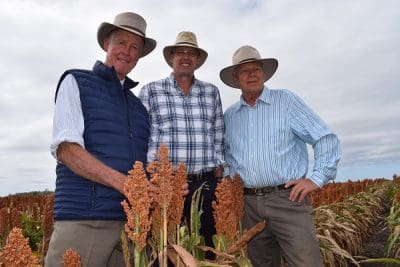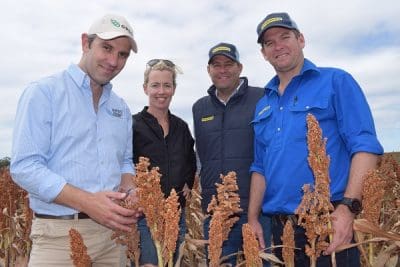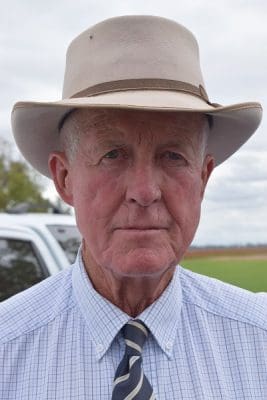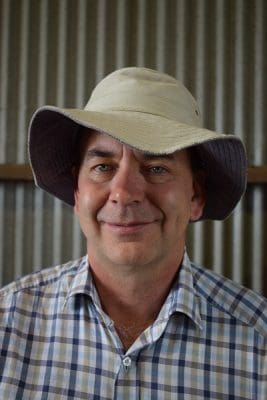THE first ‘greenfield’ research farm established in decades is taking shape on Queensland’s Darling Downs where visitors yesterday had the opportunity to inspect the first summer crop trials set up on the site.

Qld Crop Research Ltd chair, Tom Woods, Goondiwindi, director, Murray Scholz, southern NSW, and secretary, Tim Mylne, Toowoomba, inspect sorghum trials at the Yarramalong Research Centre.
In a unique arrangement, the 748-hectare Condamine River aggregation, comprising two properties, Carinya and Tosari, was acquired last year by Qld Crop Research Limited (QCR) as trustee for the Grains and Cropping R&D Trust, under a co-investment between the Grains Research Development Corporation (GRDC) and the Queensland Department of Agriculture and Fisheries (QDAF).
Still in the early stages of development, the research facility has been named the Yarramalong Research Centre and is operated by the trust, with the property vendors still farming the residual land during the transition phase.
The centre will act as a key focal point for both winter and summer crop agronomy for the northern region and will be available to both public and commercial research organisations to undertake research and develop for the Australian grains industry.
Sorghum trials have already been established on the site and discussions are underway for winter crop trials looking at commercial wheat breeding programs, crown rot, root lesion nematodes and canola agronomy.
Speaking at the open day, Qld Crop Research Ltd chair, Tom Woods, said the day gave stakeholders an opportunity to inspect the farm and appreciate the potential for it becoming a world-class research facility.
“Today was an opportunity to open the new farm up to industry participants – whether they be farmers, researchers or machinery manufacturers – to view the asset that has been purchased,” he said.
“It is a staged development. We have trials underway while we get it established as a proper research farm. We are getting a lot of mapping and engineering surveys done. Meanwhile, there are people paying for research to be done, so we are getting some income.”
Mr Woods said the farm was on prime country with all the assets needed to meet the research requirements.
“To meet the criteria it had to be a certain acreage. We have 748 hectares. There is reliable ground water and river flow water. It has a very good soil type. Good location. It is ideally suited for research facilities,” he said.
Sorghum joins National Variety Trial
The Yarramalong centre is one of the sites to host the first sorghum grown under the National Variety Trial (NVT) program.

GRDC senior manager NVT, Tom Giles, GRDC consultant NVT sorghum, Jules Dixon, with Heritage Seeds territory manager, Chris Collyer, and commercial manager, Rob Johnston.
In July last year the GRDC Northern Panel approved an investment proposal of $2.5 million over five years to design and implement a sorghum NVT program.
The program is designed to provide standardised, wide-scale performance data to help growers understand how different sorghum lines perform in different environmental conditions, as make informed decisions about what might work best in their region and importantly in their paddock.
GRDC senior manager NVT, Tom Giles, said including sorghum in the NVT had been a high priority coming through from the growers seeking to get independent variety information on sorghum.
“It went through the GRDC investment process in May last year. Between then and September we set up sorghum NVTs and now have 19 trials in the ground for this season, spread from Central Queensland, Darling Downs, northern NSW to the Liverpool Plains,” he said.
“There are seven companies involved (Advanta, Pioneer, Nuseed, Elders, Heritage, Radical Seeds and SV Genetics). From those companies we received 24 variety nominations. They are being tested in standard, three-replicate yield trials where we collect other sources of information such as soil type, germination percentage, tillering, etc.
“It is important we test these varieties across seasons to give growers the most robust information to make decisions on. From that end, the agreement with the breeding companies is the first season will not go public. We are looking to publicise results in the 2019/20 season, depending on seasonal outcomes.”
Mr Giles said the new Yarramalong Research Centre would be an important site in the NVT sorghum program.
“For NVT, research stations like this provide us with not only the security of the water and a very good planting environment in terms of intensive management of the site, but also the opportunity to co-locate against other GRDC investments where we can draw efficiencies from across trials,” he said.
“For instance, if we are going to be getting drone imagery we can get it across all the trials at one site.”
Significant breeding advances
Other sorghum trials have been established at Yarramalong, including QDAF looking into germplasm development and the University of Queensland (UQ)/Queensland Alliance for Agriculture and Food Innovation (QAAFI) running ideotype trials.
UQ professor in crop science and genetics, David Jordan, said the establishment of the Yarramalong Research Centre added another level of control and surety to their trials.
“This year one of the great advantages of this site is it has been a better yielding site. A lot of our other trials have suffered from early season stress. This is giving us an environment we wouldn’t have had otherwise, and is giving us a higher probability of getting a good trial,” he said.
“We run a breeding program at Hermitage and grow trials all over the sorghum-growing area from the Liverpool Plains up to Central Queensland. The site here is one of those sites.”
Professor Jordan said sorghum research programs over the years had achieved significant advances, including the development of lines with sorghum midge resistance and stay-green drought resistance.
“Beneath that and not observed have been the gradual improvements in yield that have been coming from the germplasm from the program. Every hybrid on the market has some genetics from the breeding program,” he said.
“In more recent years our focus, outside of yield, has been on improving the diversity of the material that is available to commercial growers. Diversity is the ‘fuel’ breeders use for making progress.
“We have also been looking at some defensive traits like root architecture to improve water extraction from depth.
“Also heat tolerance of sorghum, particularly around pollination time when it is particularly sensitive to high temperatures around 38 degrees when you can get seed loss. We are seeing increasing incidence of heat waves, so that is becoming more important.
“Quite a bit of the work we are doing on new drought-tolerance traits was funded by the Bill and Melinda Gates Foundation along with QDAF and ACIAR, which is the Australian Government.
“We also have work going on looking at photosynthesis trying to improve the ‘engine’ of sorghum.”



HAVE YOUR SAY